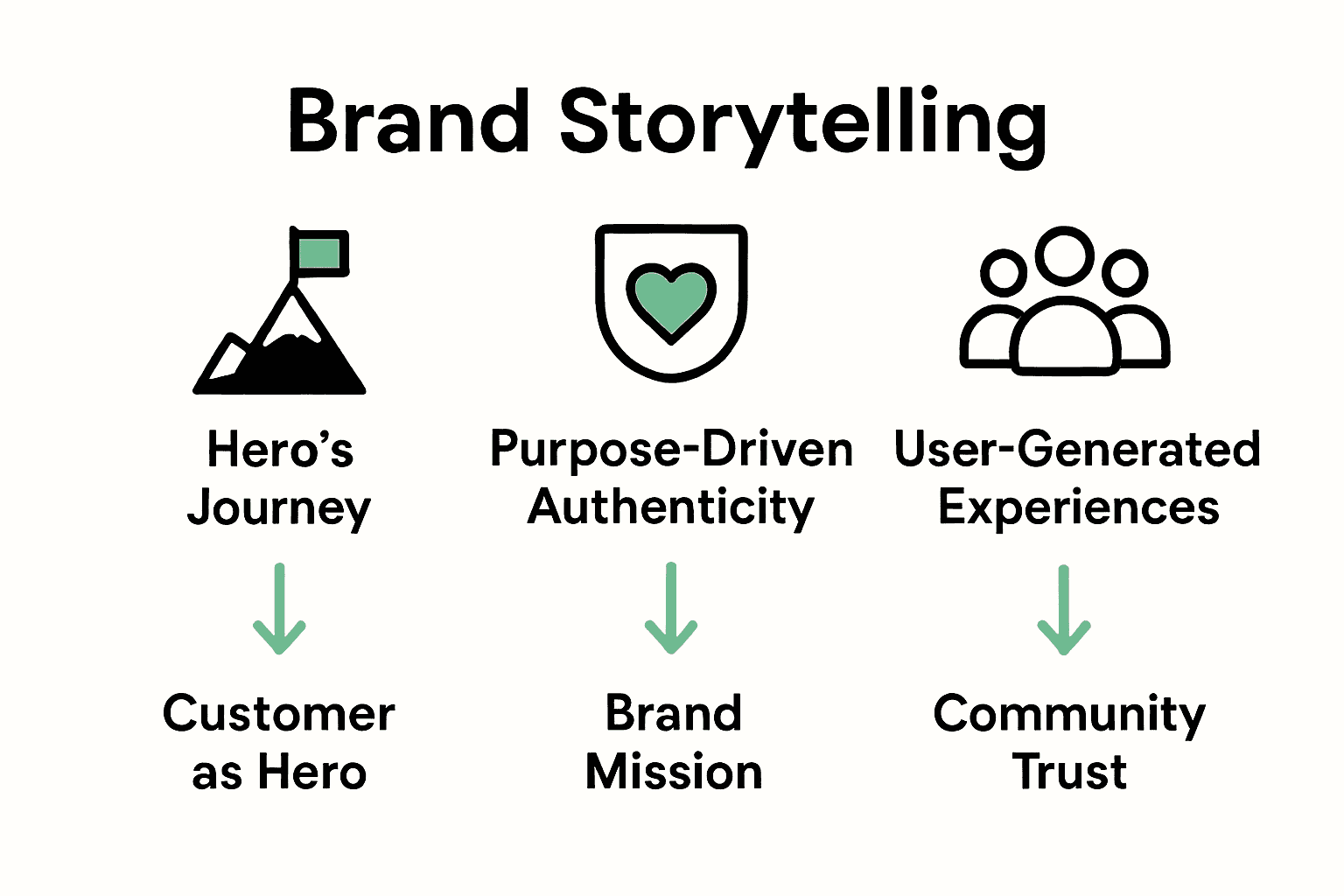Role of Storytelling in Branding: Complete Guide
- Pieter Nijssen
- Oct 17
- 6 min read

Did you know that stories increase information retention by up to 22 times compared to simple facts? Modern brands are finding that authentic, emotional storytelling forges deeper bonds with audiences and sets them apart in a crowded market. With consumers craving genuine connection and memorable experiences, mastering the art of narrative has become a vital strategy for building trust, shaping identity, and inspiring long-term loyalty.
Key Takeaways
Point | Details |
Evolving Role of Storytelling | Storytelling has shifted from a basic marketing tool to a crucial strategic element that fosters emotional connections between brands and consumers. |
Importance of Authentic Narratives | Brands must focus on crafting genuine stories that align with their values and resonate with audience experiences to build trust and engagement. |
Visual Storytelling Techniques | Utilizing emotional color palettes, character-driven narratives, and effective composition can enhance brand storytelling and create immersive experiences. |
Avoiding Common Pitfalls | Brands should ensure authenticity, align narratives with audience insights, and maintain clarity to avoid dilution and disconnection in their storytelling efforts. |
Table of Contents
Defining Storytelling in Modern Branding
Storytelling has evolved from a traditional communication tool to a strategic powerhouse in modern branding. Narrative communication now represents more than just sharing information - it’s about creating emotional connections that transform how consumers perceive and interact with brands. According to research from SIGMA storytelling practitioners, authentic narratives play a crucial role in shaping brand identity and corporate culture.
In the digital age, storytelling transcends simple marketing tactics. Neuroscience confirms that human brains are hardwired to remember stories far more effectively than isolated facts. As interdisciplinary research highlights, stories create neural pathways that make brand messages stick, turning abstract corporate communication into memorable, relatable experiences. Learn more about corporate storytelling to understand how narratives can transform your brand’s communication strategy.
Modern brand storytelling isn’t about fabricating fictional narratives, but crafting authentic narratives that resonate with audience experiences. Key elements include emotional coherence, genuine representation of brand values, and creating a narrative that invites audience participation. Whether through video content, social media, or traditional marketing channels, successful storytelling requires understanding your audience’s deeper motivations and presenting your brand’s unique journey in a compelling, transparent manner.
Types of Storytelling Used in Branding
Brand storytelling encompasses multiple narrative approaches designed to create meaningful connections with audiences. According to research examining marketing storytelling techniques, brands leverage distinct narrative strategies to communicate their unique value propositions. Discover the power of visual storytelling to understand how different storytelling types can transform brand communication.
Three primary storytelling types dominate modern branding strategies:
Here’s a comparison of the main storytelling types used in branding:
Storytelling Type | Brand Examples | Key Features |
Hero’s Journey Narrative | Nike | Customer as hero Brand as guide Inspiration |
Purpose-Driven Authenticity | Dove Patagonia | Social values Brand mission Empowerment |
User-Generated Experiences | Mailchimp | Real user stories Community focus Trust building |
Hero’s Journey Narrative: Exemplified by brands like Nike, this approach positions the customer as the protagonist overcoming challenges. The brand becomes a supportive ally helping customers achieve their goals, transforming product marketing into an inspirational narrative.
Purpose-Driven Authenticity: Brands such as Dove and Patagonia demonstrate how storytelling can communicate deeper social values. These narratives focus on brand missions that extend beyond product sales, highlighting commitment to social causes, environmental sustainability, and human empowerment.
User-Generated Story Experiences: Pioneered by companies like Mailchimp, this approach turns customer experiences into powerful brand narratives. By showcasing real user stories, brands create genuine, relatable content that builds trust and community engagement.
Successful brand storytelling isn’t about creating fictional tales, but crafting narratives that reflect genuine brand identity, customer aspirations, and shared values. The most compelling stories transcend traditional marketing, transforming commercial interactions into meaningful human connections that resonate on emotional and intellectual levels.

Visual Storytelling Techniques for Brands
Visual storytelling transforms brand communication from mere information delivery to an immersive emotional experience. According to design experts, brands can craft powerful narratives through strategic visual elements that connect deeply with audiences. Explore our essential visual storytelling strategies to understand how visual techniques can elevate your brand message.
Key visual storytelling techniques include:
Emotional Color Palette: Utilizing color symbolism and strategic color choices to evoke specific emotional responses. Warm tones might suggest energy and passion, while cool tones can communicate trust and professionalism.
Character-Driven Narratives: Incorporating relatable human or animated characters that represent your brand’s values and connect with audience experiences. These characters become visual ambassadors of your brand story.
Composition and Layout: Designing visual narratives that guide viewer attention, create visual hierarchy, and communicate brand messages through strategic image placement and design elements.
Current visual storytelling trends are pushing boundaries with innovative approaches. According to the Content Marketing Institute, emerging techniques include nostalgic aesthetics that tap into audience memories, immersive augmented reality experiences that blur digital and physical storytelling, and sustainability visuals that communicate brand values through powerful ‘show don’t tell’ imagery. The most effective visual stories don’t just display information - they create emotional landscapes that invite viewers to become part of the narrative.

Effective Storytelling in Swiss Market Examples
Swiss brand storytelling demonstrates a unique approach that balances precision, authenticity, and emotional resonance. Learn about content marketing strategies in Switzerland to understand the nuanced landscape of narrative communication in this market. According to research from Winkreative, a prominent Zurich-based creative agency, Swiss brands excel at crafting narratives that blend corporate identity with genuine storytelling.
Key examples of effective Swiss market storytelling include:
Swiss International Air Lines Rebranding: Winkreative’s work showcases how a national brand can tell a compelling story through design and consistent narrative. By creating a unified visual and communication strategy, the airline transformed its brand identity from a mere transportation service to a cultural ambassador.
Academic Narrative Research: The Institute for Applied Media Studies at ZHAW explores how Swiss corporations integrate storytelling into communication strategies. Their research highlights the importance of combining narrative techniques with factual argumentation, a distinctly Swiss approach to brand communication.
Precision Meets Emotion: Swiss brands uniquely balance technical precision with emotional storytelling, creating narratives that are both informative and deeply engaging.
The Swiss storytelling approach is characterized by its subtlety and depth. Unlike aggressive marketing tactics, these narratives focus on building long-term trust, showcasing brand values through nuanced, carefully crafted stories that respect the audience’s intelligence and emotional complexity. This approach reflects the broader Swiss cultural values of quality, precision, and meaningful communication.
Common Pitfalls and How to Avoid Them
Brand storytelling requires strategic navigation to avoid common traps that can undermine narrative effectiveness. Discover video storytelling techniques that help brands create compelling, authentic narratives. According to research from No Bullshit Marketing, several critical pitfalls can derail even well-intentioned storytelling strategies.
Common storytelling challenges include:
Lack of Authenticity: Brands often create stories that feel manufactured or disconnected from their true identity. Genuine storytelling demands transparency and alignment with actual brand values and experiences.
Audience Misalignment: Crafting narratives that don’t resonate with target audience experiences, interests, or emotional landscapes. Understanding your audience’s deeper motivations is crucial for creating meaningful connections.
Overcomplication: Attempting to include too many details or messages that dilute the core narrative. Effective storytelling requires clarity, focus, and a compelling central message.
To mitigate these risks, brands must prioritize strategic narrative development. This means conducting deep audience research, maintaining consistent brand voice, and creating stories that are both emotionally engaging and strategically aligned with business objectives. The most successful brand stories are those that feel simultaneously personal and universal, inviting audience participation while maintaining a clear, authentic brand perspective.
Transform Your Brand Story Into Impactful Visuals
Are you struggling to make your brand’s story resonate in a way that builds authentic connections and emotional engagement? This article highlighted how brands often face challenges with authenticity, audience alignment, or visual storytelling. Crafting an emotional narrative that both captures attention and clearly communicates your brand values can feel overwhelming without the right partner.

Bring your narrative to life through professional, emotionally-driven video content tailored to your unique needs. At Tulip Films, we help Swiss organizations communicate with meaning by translating complex messages into powerful audiovisual experiences. Discover how our personalized approach to visual storytelling can help your brand build real connections and drive results. Book your free consultation now to start turning your story into lasting impact.
Frequently Asked Questions
What is the importance of storytelling in branding?
Storytelling in branding is crucial as it helps create emotional connections between the brand and its audience, transforming consumer perceptions and fostering loyalty.
How can brands ensure their storytelling is authentic?
Brands can ensure authenticity by aligning their narratives with real experiences, values, and the true identity of the brand, avoiding manufactured or disconnected stories.
What are some effective types of storytelling in brand strategies?
Effective types include the Hero’s Journey Narrative, Purpose-Driven Authenticity, and User-Generated Experiences, each serving to engage audiences in unique ways.
What visual storytelling techniques can enhance brand communication?
Key visual storytelling techniques include using an emotional color palette, character-driven narratives, and strategic composition to create compelling and immersive experiences.
Recommended